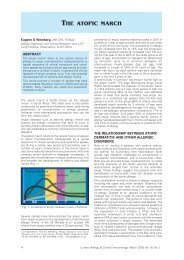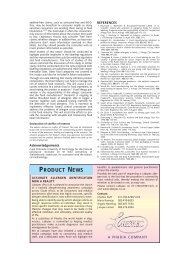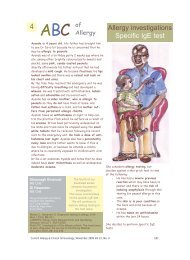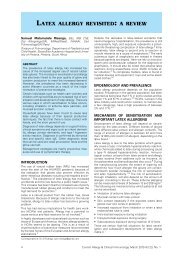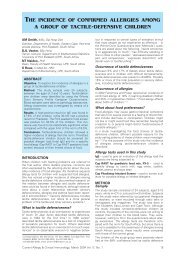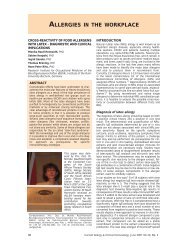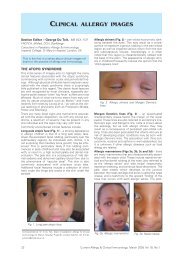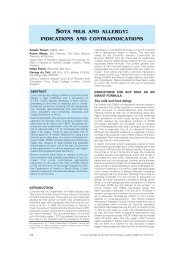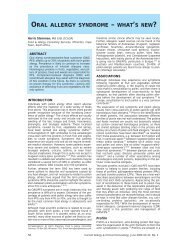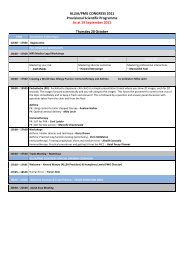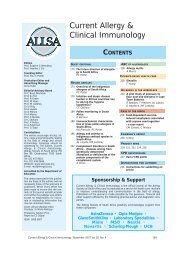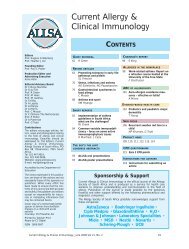Current Allergy and Clinical Immunology - March 2008
Current Allergy and Clinical Immunology - March 2008
Current Allergy and Clinical Immunology - March 2008
Create successful ePaper yourself
Turn your PDF publications into a flip-book with our unique Google optimized e-Paper software.
CPD QUESTIONNAIREEarn 2 CPD points after you have read the journal by completingthe following questionnaire online on the ALLSAwebsite at www.allergysa.org/cpd or follow the links fromthe home page. To earn points, you will need to register<strong>and</strong> fill in personal details (make sure you have yourHPCSA number h<strong>and</strong>y <strong>and</strong> decide on a password beforeh<strong>and</strong>).Once you have registered, you can answer thequestionnaire. If you have registered for a previous questionnaire,you'll need your HPCSA number <strong>and</strong> passwordto logon. Please note that there is only one correct answerper question, <strong>and</strong> you will have only one opportunity tosubmit the questionnaire, so please check answers carefully.You will be able to change anwers if you click thewrong one by mistake, but once you click 'SubmitAnswers' the test will be submitted <strong>and</strong> marked.Points will be submitted electronically to the HPCSA.The closing date for submission of this questionnaire is 30June <strong>2008</strong>.IMMUNODEFICIENCY DISEASES PRESENTING INADULTS – DIAGNOSIS AND MANAGEMENT1. True or false: Primary immune deficiency is alwaysdiagnosed in childhood <strong>and</strong> never presents for the firsttime in adults.a) Trueb) False2. True or false: Recurrent localised infections are astrong indication of underlying systemic immunedefect.a) Trueb) False3. True or false: Antibody deficiency is more common inadults than primary cellular immune defects.4. True or false: The commonest diagnosis for immunedeficiency in adult patients is common variablehypogammaglobulinaemia (CVH) which can involveboth humeral <strong>and</strong> cellular immunity.APPROACH TO THE CHILD WITH RECURRENT INFEC-TIONS – PRESENTATION AND INVESTIGATION OFPRIMARY IMMUNODEFICIENCY1. Choose ONE incorrect answer: Contributing factorsfor recurrent infections in childhood include:a) Exposure to smoke in the homeb) Day care attendance of the childc) Schoolgoing siblings in the homed) Breastfeeding (HIV-negative mother)e) Gastro-oesophageal refluxf) Anatomical obstructions2. Choose ONE incorrect answer: Cost-effective firststage initial laboratory or side room investigations inSouth Africa for a child with recurrent respiratory infectionsincludesa) Full blood count <strong>and</strong> differentialb) Immunoglobulin isotypes G, M, A, <strong>and</strong> Ec) HIV testingd) Mantoux skin teste) Lymphocyte proliferationsf) Sweat test3. Choose ONE incorrect answer:a) Deficient antibody response can occur despite normallevels of serum IgG.b) Recurrent meningococcal infections point towardsphagocyte defects.c) Absence of tonsillar tissue in the presence of recurrentbacterial infections may give a clue to defectiveB-lymphocyte development.d) X-linked agammaglobulinaemia is clinically expressedin males.e) An ulcerating BCG can be a warning sign of lack ofcellular immunity.SEVERE COMBINED IMMUNODEFICIENCY (SCID)1. True or false: All children who have SCID can be diagnosedby an absolute lymphocyte count after birth.a) Trueb) False2. True or false: The most common type of SCID isX-linked <strong>and</strong> is due to a deficiency of the commongamma chain.a) Trueb) False3. True or false: SCID should be suspected in any childwho presents early in life with severe or opportunisticinfections.a) Trueb) FalseAN UPDATE OF THE PRIMARY ANTIBODY DISORDERS1. True or false: True or false: Arrest in early B-cell developmentresults in decreasing B-lymphocyte numbers<strong>and</strong> profoundly reduced immunoglobulin isotypeconcentrations.a) Trueb) False2. True or false: Common variable immunodeficiency is aheterogenous group of diseases associated with complementdeficiencies.a) Trueb) False3. True or false: Patients with X-linked Hyper-IgMsyndrome may present with serious Pneumocystisjeroveci or Cryptosporidium infections.a) Trueb) False4. True or false: For many primary antibody deficienciesintravenous immunoglobulin G replacement therapy isthe treatment of choice.a) Trueb) FalseINTRAVENOUS IMMUNOGLOBULIN1. True or false: All IVIG preparations are equally efficacious.a) Trueb) False2. True or false: IVIG is a recommended treatment optionfor haemolytic disease of the newborn.a) Trueb) False3. True or false: The usual dose of IVIG for antibodyreplacement therapy is between 400 <strong>and</strong> 600 mg/kgevery 2-4 weeks.a) Trueb) FalseEPOXY RESIN EXPOSURE AND DERMATITIS – A CASESTUDY1. True or false: In rare cases depigmentation can resultfrom exposure to epoxy resins <strong>and</strong> is referred to as‘leucoderma’.a) Trueb) False2. True or false: Exposure to the organic solvents that areadded to some epoxy products can cause allergic contactdermatitis.a) Trueb) False3. True or false: ACD, ICD, CU, leucoderma, but not respiratoryreactions may result from exposure to epoxyresins.a) Trueb) FalseAccredited by the Colleges of Medicine of South Africa<strong>Current</strong> <strong>Allergy</strong> & <strong>Clinical</strong> <strong>Immunology</strong>, <strong>March</strong> <strong>2008</strong> Vol 21, No. 1 59



